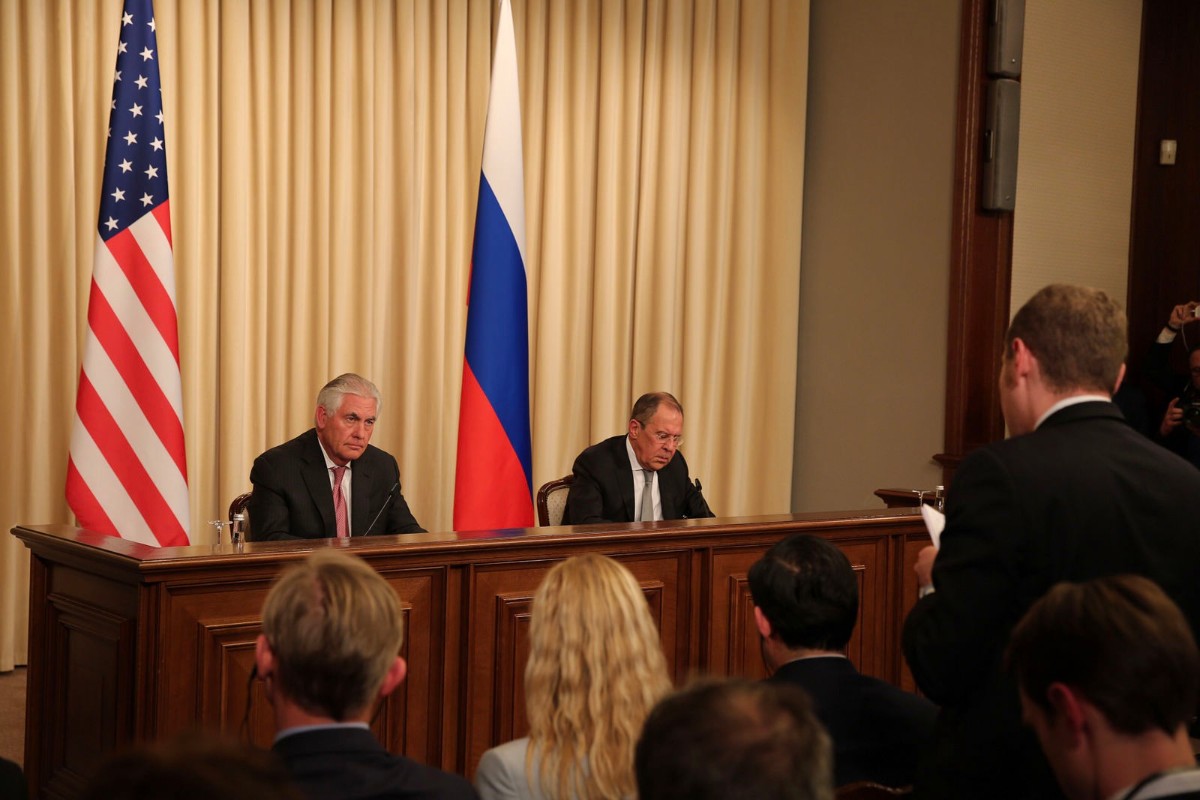
U.S. Secretary of State Rex Tillerson listens as Josh Lederman of the Associated Press asks a question during a joint press conference with Russian Foreign Minister Lavrov in Moscow, Russia, on April 12, 2017. [State Department photo / Public Domain]
NOTE: This is an archived report originally published in 2017.
As the world’s foremost nuclear powers, the relationship between the United States and Russia bears special significance for global security. While the US and Russia frequently find themselves on the opposite ends of important issues at the heart of their national interests, the inherent risk of armed conflict between the world’s strongest nuclear powers mandates that both countries work to reduce risk. Luckily, there are available areas of cooperation where both countries can work together and build trust with one another without compromising core interests that lie at the heart of ongoing controversies. Here, ASP evaluates these areas and provides specific options for promoting cooperation. ASP also seeks to explain the risks to the US associated with these options; not every plan for cooperation is necessarily worth the costs and dangers that it might entail. The current state of US-Russia relations is at the lowest level its been since the end of the Cold War, but that does not mean that the relationship must be purely antagonistic. For the sake of American security, as well as global security, cooperation should be pursued where feasible to mitigate the danger that ongoing antagonism crosses the precipice into an armed conflict that serves no one.
Click the headings of each section below for more in-depth analysis.
Since the end of the Cold War, the US, Russia, and the majority of the global community have worked together to prevent the development and proliferation of weapons of mass destruction. Historically, the US and Russia have been able to use their mutual interest in the reduction of nuclear stockpiles and the prevention of the emergence of new nuclear states to kickstart cooperation in other areas. While tensions between Russia and the US have grown over nuclear issues related to the INF, NATO development of missile shield capabilities, and the expansion of nuclear capabilities on both sides, their mutual interest in restricting the size and number of WMD stockpiles worldwide remain.
The 21st century has been home to numerous tragic terrorist attacks that have ended thousands of innocent lives throughout Russia, the United States, and the world at large. Terrorist attacks within the US and Russia have shocked and traumatized the peoples of both countries and firmly established terrorism as one of the greatest threats in modern times. From the Caucausus Emirate in southwestern Russia to lone wolf attacks in the continental US, terrorism has remained a stubborn and persistent threat against the interests of both countries. By coordinating their efforts, both countries can more effectively protect themselves and their peoples from this threat.
Following the Cold War’s conclusion, the United States and Russia have worked together extensively on mutually beneficial research through efforts like the International Space Station (ISS) and the ITER project. This cooperation was damaged after the freezing of relations between the two countries in 2014, but the reasons for cooperation in this area remain. Both countries stand to gain from pursuing research in fields ranging from space to nuclear fusion to chemistry, and the economics of staffing and supplying these projects still justify working together to minimize costs.
The US and Russia have been able to work together since the end of the Cold War to pursue environmental research in the Arctic, and have mutual interest in cooperating with one another in maritime search-and-rescue operations. If global temperatures continue to rise, northern shipping routes through previously inaccessible Arctic waters will become more common and the incentives to cooperate more powerful. Joint search-and-rescue exercise could facilitate the exchange of best practices between the two countries by combining Russia’s Arctic expertise with the US Navy and Coast Guard’s wealth of operational experience.
During, and following the conclusion of, the Cold War, the US and Russia have pursued joint research opportunities in the biomedical field. Biomedical research is essential to the improvement of public health and the development of new technologies to deal with new health risks like drug-resistant bacteria and HIV/Aids that threaten the populations of both countries. The US and Russia are currently running joint research initiatives into cancer and HIV/AIDS. Outside of research, the US and Russia both have interests in establishing interoperability capacity to deal with global health crises and to facilitate the exchange of best practices for public health practices and policies.
The international mission to build a stable and prosperous Afghanistan has been long, costly, and important. Following their ousting from power in 2001, the Taliban has waged an insurgency in Afghanistan with the goal of forcing out coalition troops, toppling the government in Kabul, and returning the country to Taliban rule. The insurgency has proved resilient and, since the US drawdown, has managed to rebound and begin to retake territory throughout the country. Due to the country’s current instability and location, Afghanistan has remained a hub for both terrorism and the drug trade. A stable, prosperous Afghanistan would serve Russian and American interests in counterterrorism, counternarcotics, and regional stability.
This report is authored in its original form by John Keaney.






